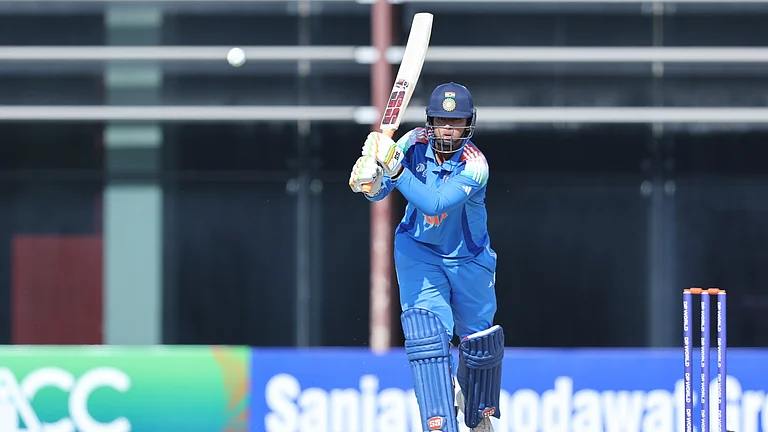IN no Indo-US dialogue in the past half century have the participants been as tightlipped as in the three rounds of talks that US deputy secretary of state Strobe Talbott has had with the prime minister's special envoy, Jaswant Singh. Despite this, as the talks have progressed, more and more of the details have seeped out. This is itself a good sign, for it shows that the two sides found more and more common ground and have begun, by degrees, to relax. In his carefully measured statement to Parliament on August 4, the PM as good as confirmed that on one key element in the discussion India and the US had virtually come to an agreement: barring some unforeseen hitch, India is likely to sign the CTBT in the not-too-distant future.
The business-like tenor of these talks, described to me by one American participant as "the most fruitful India and the US have ever held", could not have been in more marked contrast to Washington's public posture since the Pokhran tests. A stance that has been inveterately hostile. India, the American public was told, would have to be taught a lesson. Within days the US had whipped together meetings of the G-8 and the five nuclear powers, and obtained a condemnation of India that has few parallels in post-War diplomacy.
Economic sanctions were announced within days. The desire to punish India has swamped any attempt to be judicious. Secretary of state Madeleine Albright squarely blamed India for pushing Pakistan into testing its N-weapons, and contemptuously dismissed India's claim to a permanent seat in the Security Council. In virtually the same breath she exonerated China of having given Pakistan any weapons or technology for bombs or missiles 'in recent times', despite a spate of CIA reports to the contrary. China demonstrated its good faith by ensuring Pakistan got the 15 tonnes of heavy water it needs to make the unsafeguarded Khushab nuclear reactor operational.
The Talbott-Jaswant talks have been so different they could be taking place with another country, for their starting point has been an explicit US recognition that India has legitimate security concerns that made it exercise the N-option. The US has stuck to its belief that exploding nuclear bombs was not the best way of tackling them, and that was therefore a mistake. The purpose of the talks, however, is to move on and explore how India's security concerns can be reconciled with America's vital interests.
The main concern here is to keep the nonproliferation regime from unravelling. India's and Pakistan's tests could become precedents for North Korea and Iran, who make no secret of their nuclear ambitions. From this it would be a short step to the full nuclearisation of Israel, South Korea. Israel would make Iraq and Libya redouble their efforts. North Korea could make even Japan think twice. Every country that goes down this road will weaken the barriers against nuclearisation in others. The administration also fears the US armed forces may have second thoughts on ratifying the CTBT. Its most vital concern is thus to stop this domino effect.
India shares these fears, and had tried to assuage them at the very outset. In his letter to Clinton, Vajpayee had offered to sign the CTBT with some qualifications, and to take full part in the negotiations for a cap on the production of fissile materials. But an enraged West had demanded that India not only sign the CTBT without any conditions but also the NPT. In the Talbott-Jaswant negotiations, the US has dropped its insistence that India sign the NPT. It is thus willing to admit that the NPT is an unequal treaty, but it wants India to accept that the non-proliferation regime that has been built around it is the best of the available options today, and not to rock the boat.
Delinking the CTBT from the NPT has opened the way for India to sign the former. India had refused to sign the CTBT in 1996 because it would have permanently left it in the limbo of the not-quite nuclear nations, and because two of the N-powers, Britain and Russia, had at the last minute introduced an 'entry into force' (EIF) clause that prevented the treaty from coming into force till all the 44 nations with nuclear reactors signed and ratified it. This was intended specifically to put pressure on countries like India. A three-yearly review conference was to decide on steps signatories could take to bring the holdouts into the treaty. India reacted sharply to the EIF clause as it sanctioned action against non-signatories, and therefore violated the Vienna convention on international treaties.
However, once India had tested its weapons and its scientists had collected the data needed to simulate nuclear explosions, the CTBT lost its discriminatory character and ceased to constrain India's quest for nuclear security. The fact that the CTBT contains a 'national emergency' clause permitting countries to pull out in case there is a serious, demonstrable change in the security environment, further safeguards the signatories' autonomy in security matters.
Other than the CTBT, the main issues on which the talks have centred are the non-deployment of nuclear weapons and missiles; a commitment not to export nuclear technology; and willingness to sign a treaty to cap the production of fissile materials. The undertaking not to export has never presented a problem to India, which has in fact never parted with any nuclear and missile technology. The FMCT also does not seem to have posed any problems, in part as there is no agreement yet among the future signatories on a number of issues, including the verification of existing stockpiles. India will no doubt go along with any regime that does not discriminate between the nuclear and non-nuclear powers.
The issue on which the delegations have spent a good deal of time is the non-weap-onisation and non-deployment of India's (and Pakistan's) N-capability. Both terms are open to several interpretations, but here too, the US seems to have tried to meet Indian concerns halfway and has considerably watered down the G-8/P-5 demand that the two countries not manufacture missiles or bombs and not tip their existing missiles with nuclear warheads.
One US cause for concern, the possibility that India might develop N-artillery shells, seems to have been dealt with. The US delegation recounted the American experience with such weapons. Artillery units stationed in Germany in the late '50s or early '60s were issued N-artillery shells code-named the Davy Crockett. Soon after, the US military command realised that it had made a ghastly mistake, for it had given scores of captains and lieutenants in the field a finger on the nuclear trigger. The danger this entailed was brought home to it when, during a field exercise, one such unit lost its way and ended up 10 km inside East Germany. Davy Crockett was silently withdrawn.
That apart, the US has conceded that non-deployment needs to be separated from the stockpiling of N-weapons. But deployment can have a wide range of meanings, from a Jaguar at the end of the runway with bombs strapped to its underside, to N-tipped missiles in hard ened silos within range of each other's civilian centres American fears have cen tred on the possibility of accidental N-war, as neither Pakistan nor India has even rudimentary command and control systems, and that while India has at least one military satellite, Pakistan does not have even that, and therefore is essentially blind. And yet their missiles are only four minutes away from each other.
Some weeks ago, the outgoing US ambassador in Islamabad underlined this when he expressed his deep worry at the fact that Pakistan had decided to explode its bombs and declare a national alert, which included readying its missiles for launching at India, on the basis of an unfounded rumour that there were Israeli aircraft at Indian air bases. Talbott's delegation has therefore focused its efforts on getting India and Pakistan to move their Prithvi and M-11 missiles out of range of each other's territory. India has no quarrel with that, although questions still remain to be resolved because of perceived Indo-Pak asymmetries in missile capability.
Vajpayee has decided to move ahead on the CTBT because in these talks India has got what it wants—acceptance of its need for a minimum nuclear deterrent. Beyond that it has everything to gain from keeping the global nuclear non-proliferation regime intact. The absence of any hint of admonition in Albright's statement at the ASEAN Regional Forum meet in Manila, and the welcome given to Vajpayee's statement by James Rubin of the state department in Washington, together suggest that Washington's 'good cop, bad cop' routine may be coming to an end.






















